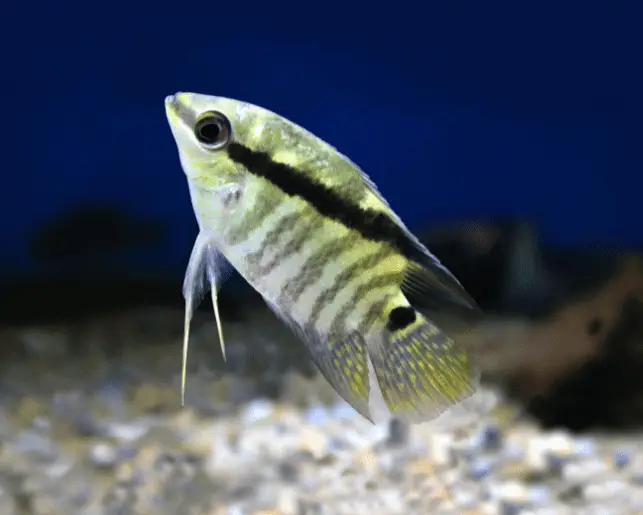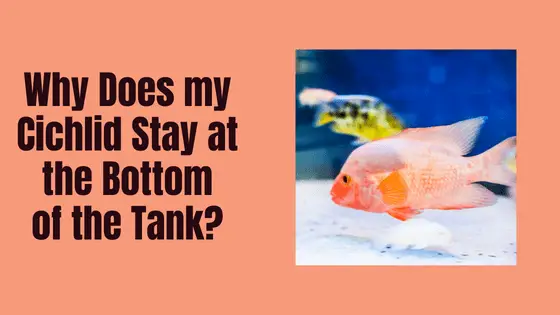Cichlids are a popular freshwater fish species that are known for their vibrant colors and active behavior. They are often found swimming in the middle and upper levels of the aquarium, but sometimes they can be seen hovering or resting at the bottom of the tank. This can be concerning for fish owners, as it can indicate that something is wrong with the fish’s health or behavior.
Cichlids may stay at the bottom of the tank due to stress, illness, territorial behaviour or old age. This behaviour can also signify that your tank isn’t the best environment for your fish. Staying near the bottom of the tank may be a sign that you need to perform a water change or adjust the temperature.
The rest of this article will tell you everything you need to know about bottom-dwelling cichlids, so you can better understand what this behaviour means and how to address the different problems it can signify. Read on to learn more.

Why Is My Cichlid Lying at the Bottom of the Tank?
Here are some reasons why your cichlid is lying at the bottom of the tank:
Stress:
One of the most common reasons why cichlids stay at the bottom of the tank is stress. Cichlids are known for their aggressive behavior and can become stressed if they feel threatened or if the aquarium conditions are not suitable for their needs. Common stressors can include poor water quality, overcrowding, lack of hiding places, or aggressive tank mates. If you suspect stress is the cause, it’s important to identify and address the underlying issue to help your cichlid return to normal behavior.
Illness:
Another possible reason why a cichlid may stay at the bottom of the tank is illness. Cichlids can be prone to a range of health issues, including bacterial or fungal infections, parasites, and swim bladder disease. If you notice any other symptoms such as loss of appetite, lethargy, or abnormal swimming behavior, it’s important to consult with a veterinarian or experienced fish keeper to diagnose and treat the underlying issue.
Territorial behavior:
Cichlids are known for their territorial behavior and can sometimes stay at the bottom of the tank to protect their territory. This is particularly common in breeding pairs, where one fish may guard the eggs or fry while the other ventures out for food. Providing suitable hiding places and ensuring there is enough space in the aquarium can help reduce territorial aggression and encourage your cichlid to swim at different levels of the tank.
Temperature or water chemistry issues:
Cichlids are sensitive to changes in water temperature and chemistry, and sudden fluctuations can cause stress or illness. If you notice that your cichlid is staying at the bottom of the tank, check the water temperature and test the water chemistry to ensure it is within suitable ranges for your fish. Maintaining a stable and appropriate environment can help your cichlid feel more comfortable and reduce the risk of stress or illness.
Age:
Finally, it’s important to consider the age of your cichlid. As fish age, they may become less active and prefer to rest more often. This is a normal part of the aging process and may not indicate any underlying health or behavioral issues.
Do Pregnant Cichlids Stay at the Bottom of the Tank?
Pregnant cichlids may sometimes stay at the bottom of the tank, especially when they are guarding their eggs or fry. This behavior is a natural instinct to protect their offspring from potential predators or other fish in the aquarium. However, if a pregnant cichlid is staying at the bottom of the tank for an extended period of time and shows signs of stress or illness, it’s important to identify and address the underlying issue to ensure the health and well-being of both the mother and her offspring.
But how exactly can you tell if your cichlid is pregnant or not?
How To Tell if Your Molly Fish Is Pregnant.
Cichlids are known for their unique breeding behaviors, and there are several ways to tell if your cichlid is pregnant or carrying eggs:
- Swollen abdomen: One of the most common signs of pregnancy in cichlids is a swollen abdomen. The fish’s belly may appear larger and more rounded than usual.
- Darker coloration: Female cichlids may exhibit a darker coloration around the abdomen when they are carrying eggs. This is due to increased blood flow to the area.
- Increased appetite: Pregnant cichlids may exhibit an increased appetite as they prepare to lay their eggs.
- Aggressive behavior: Female cichlids may become more aggressive towards other fish in the aquarium as they prepare to lay their eggs and protect their territory.
- Nest building: Some cichlid species may build nests or dig pits in the substrate when preparing to lay their eggs.
It’s important to note that not all female cichlids will exhibit these behaviors, and some may carry their eggs internally until they are ready to lay them. If you suspect your cichlid may be pregnant, it’s important to provide appropriate breeding conditions and monitor the fish’s behavior closely to ensure a successful breeding process.
This mesmerising YouTube video shows an african cichlid releasing fry from its mouth.
Are Cichlids Fish Bottom Dwellers?
Cichlids are not necessarily bottom dwellers by nature. While some species may spend more time near the bottom of the tank, others may prefer to swim in the middle or top portions of the aquarium. Cichlids are a diverse group of fish that come from a variety of habitats, including rivers, lakes, and streams, and their behavior can vary depending on their natural environment and specific species.

Signs of Illness To Look Out For.
Unfortunately, a bottom-dwelling cichlid might be a sick cichlid.
As previously discussed, mollies aren’t natural bottom-dwellers like loaches and other common bottom-feeder species. If you’re convinced that your fish isn’t pregnant, it’s essential to check for symptoms of common fish illnesses.
Here are some illnesses and ailments you should check for:
- Ich: Ich is one of the most common illnesses seen in freshwater fish. It’s a parasitic infection that causes white spots to appear on your fish.
- Swim bladder infections: An infected swim bladder can affect your pet’s ability to swim properly.
- Fin rot: Fin rot is relatively easy to diagnose. While this is more common in bettas and other fish with more elegant tails, mollies can still be prone to this.
- Poisoning (contaminated water): Unfortunately, it’s all too easy to contaminate the water in your fish tank accidentally. If you use harsh soaps to clean your fish care supplies, the chemicals in the soap can transfer over to your tank. You should also have a designated bucket for water changes to protect your fish from cleaning solutions.
- Chlorine sickness: It’s imperative to ensure that the water in your fish tank is dechlorinated. If you forget this step during cleaning and/or water changes, this can make your fish very sick.
In addition to bottom-dwelling behaviour, here are some signs of illness that you should look out for:
- White spots (ich)
- Slowed movements
- Rotted fins
- Your fish isn’t eating
- Increased or decreased aggression (depending on the typical behaviour of the individual fish)
How To Treat Common Illnesses.
If you think your fish is suffering from an illness, it’s crucial to treat your tank properly. One easy fix is, surprisingly, garlic. Garlic has strong antiparasitic properties for both humans and animals, so it works really well for treating ich. By placing a piece of garlic in your fish tank, you can quickly rid it of ich and keep your fish healthy.
Garlic is also antibacterial and antifungal, which means that it can help soothe the symptoms of fin rot as well.
Do Cichlids Like To Hide?
Cichlids are known for their love of hiding places. In their natural habitats, cichlids typically live among rocks, caves, and other structures that provide shelter and protection from predators. In an aquarium environment, it’s important to provide cichlids with plenty of hiding places to help them feel safe and secure.
If your fish stays close to the bottom to hide, this is probably nothing to worry about. It’s still a good idea to double-check for symptoms of pregnancy and illness for safety.

Final Thoughts.
In conclusion, there are several reasons why a cichlid may stay at the bottom of the tank, and it’s important to identify and address the underlying cause to ensure the health and well-being of your fish. By addressing issues such as stress, illness, territorial behavior, temperature or water chemistry issues, or age, you can encourage your cichlid to return to normal behavior and thrive in their aquarium environment.

